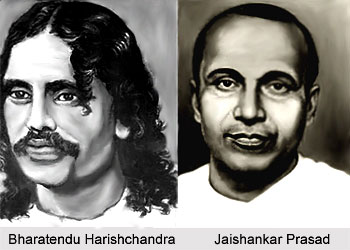 Hindi theatre has a tradition spanning more than four centuries. Hindi theatre can be said to be the continuity of Sanskrit theatre. It is eminent in different literary languages or spoken dialects of many states of northern India like Uttar Pradesh, Bihar, Jharkhand, Madhya Pradesh, Chhattisgarh, Rajasthan, Haryana, Himachal Pradesh, and Uttarakhand. Developed in theatre began to take place particularly in the coastal cities of Kolkata, Mumbai, and Chennai. The English had established their commercial, administrative, and military strongholds in these places.
Hindi theatre has a tradition spanning more than four centuries. Hindi theatre can be said to be the continuity of Sanskrit theatre. It is eminent in different literary languages or spoken dialects of many states of northern India like Uttar Pradesh, Bihar, Jharkhand, Madhya Pradesh, Chhattisgarh, Rajasthan, Haryana, Himachal Pradesh, and Uttarakhand. Developed in theatre began to take place particularly in the coastal cities of Kolkata, Mumbai, and Chennai. The English had established their commercial, administrative, and military strongholds in these places.
Pioneers of Hindi Theatre
There were many pioneers in the field of Hindi Theatre. One of the important pioneers had been the poet-playwright from Varanasi, Bharatendu Harishchandra (1850-85). He is credited with initiating the Hindi Theatre by establishing an amateur group with his literary associates, writing, staging, and acting in his own and other plays. He even at times travelled to nearby towns in Uttar Pradesh and Bihar with his productions. Janaki mangal (`Janaki`s Marriage`, 1867) is the first such drama composed by one of the associates of Harishchandra, Sitala Prasad Tripathi, and produced in Varanasi. Harishchandra with his expertise and imaginative skills explored the different forms of Hindi region. He had even made researches in the Bengali, Sanskrit region and the newly introduced Shakespearean model. However, this process of modernisation of Hindi theatre could not live long.
After the premature death of Bharatendu, the resourceful Parsi companies visiting the Hindi towns at regular intervals swamped the Hindi theatre. The next breakthrough in the Hindi Theatre came with the emergence of another renowned playwright in Varanasi, Jaishankar Prasad. In the first quarter of the twentieth century he was the senior most authors among the trio of the new romantic school of Hindi poetry. Jaishankar Prasad was a recognized Indian dramatist. He is credited with writing about a dozen plays that took the Hindi theatre to a new level as well as gave it a considerable mode of creative expression.
In the 1940s, two major developments gave a boost to the Hindi Theatre. The launching of the Indian People`s Theatre Association (IPTA) in 1943 by the Communist Party of India resulted in the writing and staging of new plays with a direct and immediate political and social message. It soon spread to towns in the entire Hindi-speaking area
IPTA helped in stimulating wide, sustained interest in theatre and attracted or inspired activists and talented practitioners like the famous actor Balraj Sahni (1913-73) and Habib Tanvir (1923). It also gave unprecedented respectability to theatre in the socially conservative Hindi community. Meanwhile Prithvi Theatre, a professional travelling company was set up by the famous film star Prithviraj Kapoor (1906-72) in 1944. It staged purposeful Hindi plays with a rare dedication and competence.




